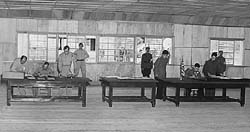 |
 |
 |
|||
 |
Home | Cold War Turns Hot | The Armed Forces Integrate | What the Experts Say | |||
|
The Cold War Turns Hot
A Necessary War? "I argue that the Korean War was fundamental in shaping the Cold War as we know it," says historian William Stueck of the University of Georgia. In the years just before the Korean conflict, Stueck says, the Soviet Union's vastly superior military strength made the world unstable and dangerous. Korea woke up the West; it kick-started Truman's military build-up and led to a strengthening of NATO. The result: a new balance of power that would contain the Soviet Union until its collapse four decades later, Stueck says. "So I call it in some ways a substitute for World War III, or even, perhaps, a necessary war." Korea would also serve as a Cold War prelude to the next, far less popular war - in Vietnam.
Peace talks began on July 10th, 1951, but quickly bogged down in mistrust and recriminations. The talks would continue, haltingly, for more than two years. So would bloody battles for small pieces of ground with nicknames like Heartbreak Ridge and Pork Chop Hill. The stalemate broke in 1953 after both superpowers got new leadership. In Moscow, Stalin died and was replaced by the more moderate Georgi Malenkov. President Dwight Eisenhower took office and kept a campaign promise to stop the fighting. An armistice - though not a peace treaty - was signed on July 27th, 1953.
"Oh, I was happy it was over," Vince recalls, "because I would soon learn that my brother might be coming home." Vince had reason to believe that might happen. He'd learned that Richard had not been killed at Kunu-ri in December, 1950, but had been captured by the Chinese. In the spring of 1951, a relative had spotted Richard in a newspaper photograph of POWs. The photo had been released by the Chinese for propaganda purposes. Now, with the war over, "my family and I just kept looking and looking at the lists of those repatriated [POWs], and we never saw his name." Chinese and North Korean POW camps were notorious. Some lacked food, shelter and medicine. 2,800 Americans, more a third of those taken prisoner, died in captivity during the war. Many were marched to death. Hundreds were simply executed. Vince found a few returning men who'd been captured with Richard. They said they'd heard that Richard had died. That was all. Vince got no more solid information until December first, 1998 - exactly 48 years after Richard was captured. That day a letter arrived from one Ron Lovejoy. Next: Closure
|
||||

